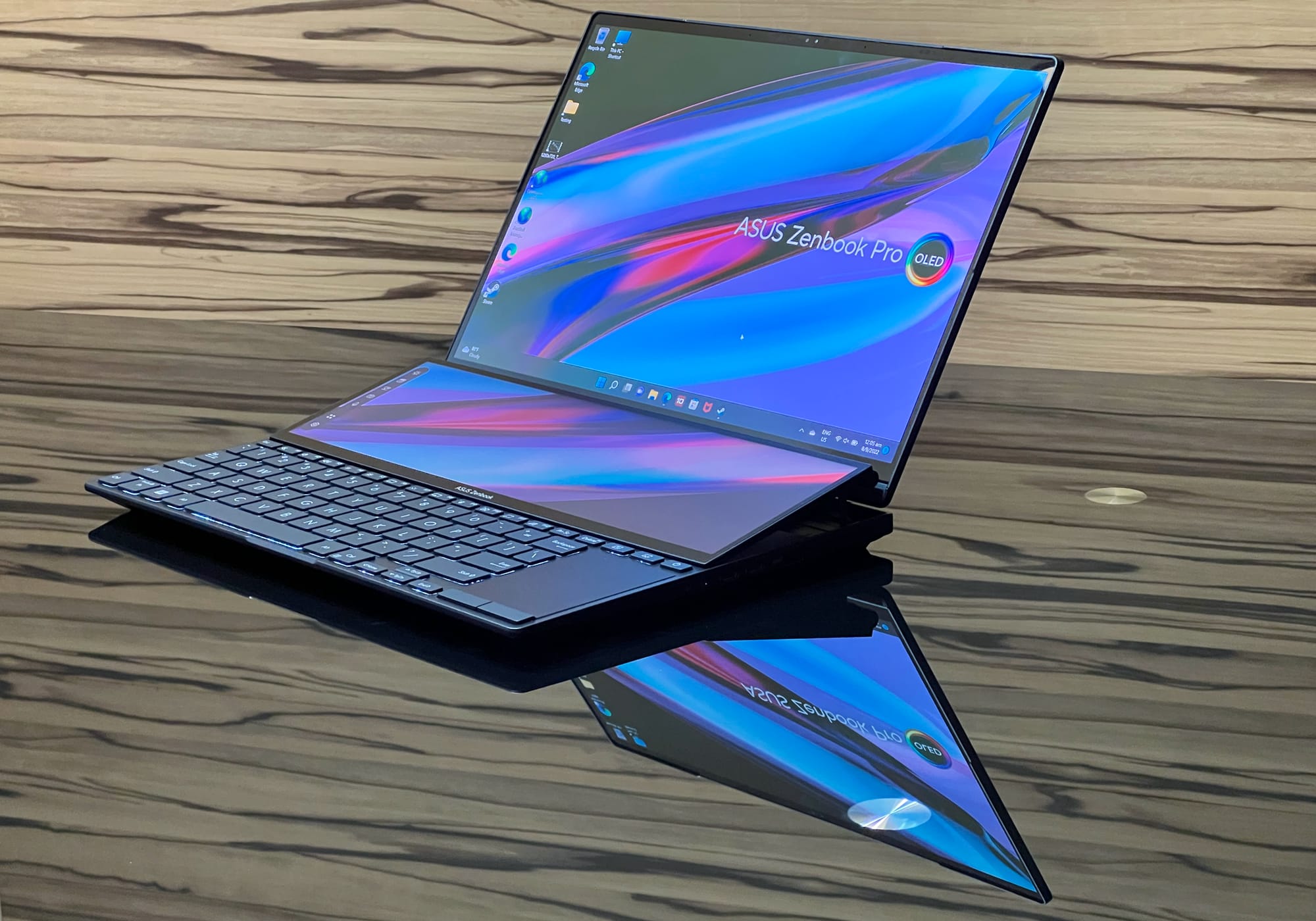I need at least two displays in order to be productive, whether it is in office or at home. But on the road, you are usually stuck with a single display when you carry a laptop. Not so, if you have the Asus ZenBook Pro 14 Duo OLED.
This laptop features two touchscreen displays for your productivity needs. The main one is a 14.5-inch (2,880 x 1,800 pixels) touchscreen OLED display, while the secondary display is a 12.7-inch (2,880 x 864 pixels) ScreenPad Plus.
- Price: From S$3,699, get it at Shopee, Lazada and Asus Store
- Processor: Intel Core i7-12700H 2.3GHz
- Graphics: Nvidia GeForce RTX 3050 Ti Laptop GPU with 4GB video memory
- Main Display: 14.5-inch OLED WQXGA+ (2,880 x 1,800 pixels) touchscreen; 120Hz refresh rate
- Secondary Display: 12.7-inch (2,880 x 864 pixels) touchscreen; 120Hz refresh rate
- Memory: 16GB
- Storage: 1TB SSD
- Battery: 76Wh
- Weight: 1.75kg
On the outside, the ZenBook Pro 14 Duo OLED looks no different from last year’s ZenBook Duo 14. You still get the concentric circles on the lid emanating from the logo. Only this time, it is not an Asus logo but the new ZenBook logo.

When you open the lid, you will find the secondary screen – ScreenPad Plus – tilting above the laptop’s keyboard. Unlike its predecessor in which the ScreenPad Plus only tilts at 7 degrees, this iteration can tilt at 12 degrees.
This increase in the tilting angle allows the two displays to look more like one. As such, you can be more natural in your sitting position to look at the “entire” screen. Also, the higher tilting angle is supposed to help in its cooling performance by allow more air to pass through.

The ScreenPad Plus comes with its own software sited on its left side as a vertical row of controls. This row of controls lets you change its brightness, lock and unlock the keyboard or open the App Launcher. The App Launcher lets you open apps, such as number pad or Spotify, on the ScreenPad Plus.
You can put two apps nicely side by side on the ScreenPad Plus or flick one app from the main display down to the ScreenPad Plus and vice versa. Or you can open a browser on the ScreenPad Plus to look at walkthrough while playing a role-playing game on the main display.

Not to mention, both displays have a refresh rate of up to 120H and supports 100% of the DCI-P3 colour space. Both displays are sharp and gorgeous to look at.
On the downside, the secondary display causes the keyboard to be really cramped. The trackpad is also really small, being tugged on the right corner. As a result, there are no space of wrist rests.
While you can use the ScreenPad Plus as a giant trackpad, it seems like a pity to use such a big screen estate for that purpose. I recommend a mouse instead.

On the other hand, the laptop have all the ports you need for peripherals. On its left side, there is a 3.5mm audio jack. On the right, there is a one USB-A port and two USB-C Thunderbolt 4 ports that support power delivery. At its rear, you will find the power port, a HDMI 2.1 port and a microSD card reader.
Despite having all these ports, the laptop is only 1.96cm at its thickest and weighs a mere 1.75kg. Compact and lightweight for a dual-screen laptop.
Powered by the latest 12th-generation Intel Core i7 processor, this laptop is obviously no slouch. In the PCMark 10 benchmark tests, the laptop scored an impressive 6,765. This is almost on par with some gaming laptops like the Razer Blade 15 Advanced Model (2022) that scored 6,886 or the Alienware x15’s score of 6,711.
| PRO | CONS |
| Sleek design | Expensive |
| Portable for its class | Cramped keyboard |
| Gorgeous dual displays | Small trackpad |
| Better seconday display | No space to rest your wrists |
| Secondary display can be used as trackpad | Battery life can be improved |
| Good number of ports | |
| Great performance |
In real life scenarios, the ZenBook Duo 14 does all tasks quickly and responsively. You will have no issues opening multiple tabs on any browsers or feel any lag when editing your videos or photos.
For gaming, this laptop did surprisingly well, which is probably due to its dedicated Nvidia GeForce RTX 3050 Ti Laptop GPU. For instance, in the graphics-intensive game Cyberpunk 2077, the frame rates can reach a decent 35 frames per second (fps) when the graphics is set to High. And the game plays really smoothly even when the secondary display houses a browser at the same time.

Perhaps the biggest downer of ZenBook Pro 14 Duo OLED is its battery life. In our video-loop battery test whereby a HD video is looped only on the main display but with both displays at full brightness, it lasted only 4 hours 45 minutes. Last year’s ZenBook Duo 14 lasted 3 hours more.
VERDICT: With a price tag of S$3,699, the Asus ZenBook Pro 14 Duo OLED is undoubtedly quite expensive. That said, you pay for what you get. It is a sleek and powerful dual-display laptop that you can take on the road.
